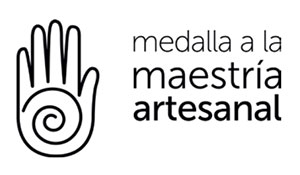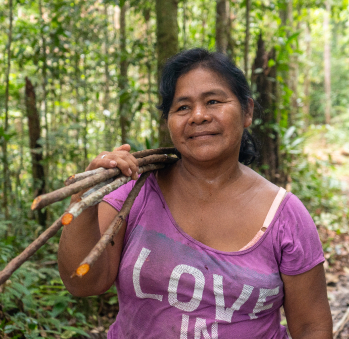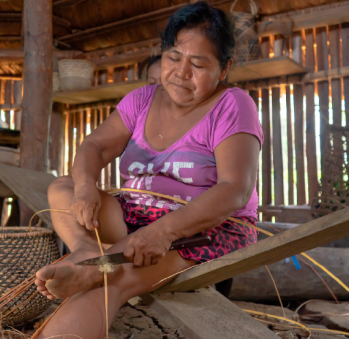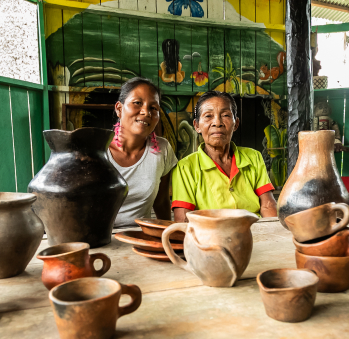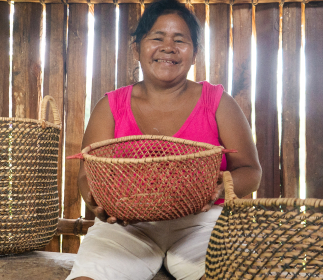Rosa Amelia Meicuaco
SCHEDULE YOUR VISIT
Comunidad Km 22, Leticia, Amazonas
3227069412
3123292257
roame@gmail.com
She says that the bejucos (aerial roots) practically have their own life. The guambé or burro (philodendron) hangs high from trees: you have to take down its 50 or 60 bejucos very carefully. The yaré (Heteropsis flexuosa) hangs lower and is rougher. The alcalde negro (Desmoncus) is found on the banks of the waterfalls and is so long that it is mistaken for 50-meter-long boa constrictors. It is also very spiny, but it is so beautiful that craftspeople insist in making baskets with it.
Rosa Amelia is a member of the Bora community. She is thus able to explain to us that, to be able to harvest the raw materials with which they work, they must first pray to their god Niimúhe in a ceremony with the elder leaders and their grandchildren. Otherwise, the bejucos will deeply wound their hands when they find and harvest them.
These indigenous people originally come from the district of La Chorrera in the department of Amazonas, right in the center of the Amazon rainforest. Those who recognize this name will remember that it was the epicenter of the rubber extraction industry at the beginning of the 20th century. It also became known years later as a hell filled with indigenous slaves. Many of the Bora people died there and many others were forcibly displaced to Perú. As if all of this were not enough, decades later, the descendants of those who managed to survive suffered violent harassment and imprisonments by the hands of the armed guerilla groups that expanded their territory through the rainforest.
Rosa Amelia and her seven children were forced to move to Leticia in 2002. Even though she struggled to make enough money to feed her family at the beginning, she quickly learned how to use her knowledge of weaving as a source of sustenance. There, in the Amazonian capital city, she met other people like her: other people who had been uprooted. Yet, knowing she had a vocation in the dexterity of her own hands, she started to weave baskets, bags, hats, sieves, fruit bowls, and rugs. In her own prideful words, “I wove anything I could think of.”
She knows that she is one of the very few people who can weave with guambé (philodendron), because it is difficult to work with. It produces an itchy resin that you have to boil in huge pots to remove. She also enjoys working with the thorny alcalde (Desmoncus). It is evident that she enjoys being challenged. The fibers she extracts pass through a tin plate full of holes, just like how gold filigree threads are made. This is done to refine them and give them a uniform thickness.
The pandemic forced her to make an important choice. She moved to Kilometer 22 of Leticia, on the Calderón road, and settled in Cihtacoyd, the Community of the Indigenous Council of the Tobacco, Coca, and Cassava Heirs. The latter is a reservation in which seven indigenous communities live together and share their customs. The communities that live there are the Bora, Yukuna, Huitoto, Miraña, Tanimuka, Murú and Muinane.
Each one of them practices their own traditions and exchanges their knowledge and rituals with these and other neighboring communities. They accompany their customary dances, the charapa turtle, heron, and plank, with tobacco, coca, mojojoy grub worm, and all of the Amazon’s fruits: açaí, bacaba fruit, peach palm, pineapple, and grapes. These communities also barter and pay what they owe with cassava bread, cassava starch, and peanuts. This reservation, which has the rainforest right at its doorstep, has helped its communities experience a rebirth. They have been able to continue weaving and caring for life.
Craft






Artisans along the way
Artisans along the way
No puede copiar contenido de esta página








































